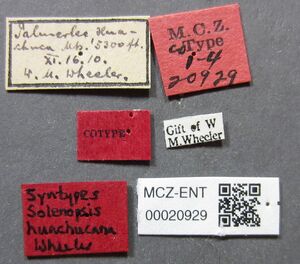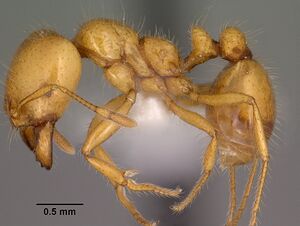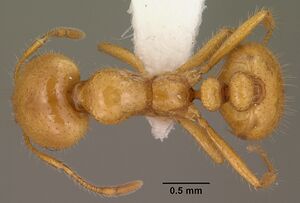Solenopsis aurea
| Solenopsis aurea | |
|---|---|

| |
| Scientific classification | |
| Kingdom: | Animalia |
| Phylum: | Arthropoda |
| Class: | Insecta |
| Order: | Hymenoptera |
| Family: | Formicidae |
| Subfamily: | Myrmicinae |
| Tribe: | Solenopsidini |
| Genus: | Solenopsis |
| Species group: | geminata |
| Species: | S. aurea |
| Binomial name | |
| Solenopsis aurea Wheeler, W.M., 1906 | |
| Synonyms | |
| |
This species is found mainly in desert and dry grassland regions across the southwestern United States and northern Mexico (Trager, 1991). Colonies are often found under stones (or other objects, such as pieces of wood or cow manure) in loam or coarse gravely soils or in soil surrounded by a small mound. Dealate females have been collected in July and August (Mackay and Mackay 2002). In Nevada Cole (1966) found colonies to be small and few.
Identification
A member of the Solenopsis geminata species-group.
Workers lighter in color with a light colored gaster, often with brown patches. The eyes are small (about 50 ommatidia in the major, 20 in the minor), being separated from the insertion of the mandibles by about twice the maximum diameter of the eyes. The majors have lateral teeth on the clypeus. (Mackay and Mackay 2002)
Distribution
United States: California east to Texas. Mexico: Chihuahua, Durango, Jalisco, Nuevo León, Zacatecas.
Latitudinal Distribution Pattern
Latitudinal Range: 39.767453° to 18.276944°.
| North Temperate |
North Subtropical |
Tropical | South Subtropical |
South Temperate |
- Source: AntMaps
Distribution based on Regional Taxon Lists
Nearctic Region: United States (type locality).
Neotropical Region: Mexico.
Distribution based on AntMaps
Distribution based on AntWeb specimens
Check data from AntWeb
Countries Occupied
| Number of countries occupied by this species based on AntWiki Regional Taxon Lists. In general, fewer countries occupied indicates a narrower range, while more countries indicates a more widespread species. |

|
Habitat
Chihuahuan Desert in a variety of habitats (black grama grassland, creosotebush scrub, mesquite and thorn scrub), as well as in urban habitats. (Mackay and Mackay 2002)
Biology
Association with Other Organisms
 Explore: Show all Associate data or Search these data. See also a list of all data tables or learn how data is managed.
Explore: Show all Associate data or Search these data. See also a list of all data tables or learn how data is managed.
- This species is a host for the phorid fly Pseudacteon crawfordi (a parasitoid) (Quevillon, 2018) (encounter mode primary; direct transmission; transmission outside nest).
Castes
Worker
       
| |
| . | Owned by Museum of Comparative Zoology. |
Images from AntWeb
   
| |
| Worker. Specimen code casent0102899. Photographer April Nobile, uploaded by California Academy of Sciences. | Owned by CAS, San Francisco, CA, USA. |
Nomenclature
The following information is derived from Barry Bolton's Online Catalogue of the Ants of the World.
- aurea. Solenopsis geminata var. aurea Wheeler, W.M. 1906d: 336 (w.q.m.) U.S.A. (Texas, California, Arizona).
- Type-material: syntype workers, syntype queens, syntype males (numbers not stated).
- Type-locality: U.S.A.: Texas, Mt Bonnel, nr Austin (W.M. Wheeler).
- Type-depositories: LACM, MCZC.
- Crozier, 1970: 116 (k.).
- Subspecies of geminata: Wheeler, W.M. 1908e: 425; Ettershank, 1966: 139 (error).
- Subspecies of xyloni: Creighton, 1930b: 103; Cole, 1937a: 99; Smith, M.R. 1951a: 812.
- Status as species: Forel, 1909a: 269; Wheeler, W.M. 1910g: 563; Wheeler, W.M. 1915b: 394; Emery, 1922e: 196; Creighton, 1950a: 230; Cole, 1953g: 299; Smith, M.R. 1958c: 129; Snelling, R.R. 1963: 6; Cole, 1966: 16 (in key); Smith, M.R. 1967: 357; Kempf, 1972a: 233; Hunt & Snelling, 1975: 22; Smith, D.R. 1979: 1385; Snelling, R.R. & George, 1979:133; Dlussky, 1981a: 48; Allred, 1982: 504; Wheeler, G.C. & Wheeler, J. 1986g: 50; Trager, 1991: 169 (redescription); Bolton, 1995b: 386; Mackay & Mackay, 2002: 228; Ward, 2005: 67.
- Senior synonym of huachucana: Trager, 1991: 170; Bolton, 1995b: 386.
- Distribution: Mexico, U.S.A.
- huachucana. Solenopsis huachucana Wheeler, W.M. 1915b: 393 (w.q.) U.S.A. (Arizona).
- Type-material: syntype workers (number not stated, “numerous”), 2 syntype queens.
- Type-locality: U.S.A: Arizona, Huachuca Mts, Miller Cañon, ca 5500 ft (W.M. Wheeler).
- Type-depositories: LACM, MCZC.
- Combination in S. (Euophthalma): Creighton, 1930b: 118.
- Status as species: Emery, 1922e: 197; Creighton, 1930b: 118 (redescription); Cole, 1937a: 99; Creighton, 1950a: 233; Smith, M.R. 1951a: 813; Smith, M.R. 1958c: 129; Ettershank, 1966: 141; Hunt & Snelling, 1975: 22; Smith, D.R. 1979: 1386.
- Junior synonym of aurea: Trager, 1991: 170; Bolton, 1995b: 388.
Type Material
- Solenopsis geminata aurea: Syntype, workers, queen, Austin, Texas, United States, Museum of Comparative Zoology, Los Angeles County Museum of Natural History.
- Solenopsis huachucana: Syntype, workers, queen, Miller Canyon, Huachuca Mountains, Arizona, United States, Museum of Comparative Zoology.
Description
Karyotype
- See additional details at the Ant Chromosome Database.
 Explore: Show all Karyotype data or Search these data. See also a list of all data tables or learn how data is managed.
Explore: Show all Karyotype data or Search these data. See also a list of all data tables or learn how data is managed.
- n = 16, 2n = 32 (USA) (Crozier, 1970b).
References
- Ajayi, O.S., Appel, A.G., Chen, L., Fadamiro, H.Y. 2020. Comparative Cutaneous Water Loss and Desiccation Tolerance of Four Solenopsis spp. (Hymenoptera: Formicidae) in the Southeastern United States. Insects 11, 418. (doi:10.3390/INSECTS11070418).
- Cole, A. C., Jr. 1966b. Ants of the Nevada Test Site. Brigham Young Univ. Sci. Bull. Biol. Ser. 7(3): 1-27.
- Creighton, W. S. 1930b. The New World species of the genus Solenopsis (Hymenop. Formicidae). Proc. Am. Acad. Arts Sci. 66: 39-151 (page 103, Subspecies of xyloni)
- Creighton, W. S. 1950a. The ants of North America. Bulletin of the Museum of Comparative Zoology 104: 1-585 (page 230, Revived status as species)
- Crozier, R. H. 1970a. Karyotypes of twenty-one ant species (Hymenoptera: Formicidae), with reviews of the known ant karyotypes. Can. J. Genet. Cytol. 12: 109-128 (page 116, karyotype described)
- Forel, A. 1909a. Ameisen aus Guatemala usw., Paraguay und Argentinien (Hym.). Dtsch. Entomol. Z. 1909: 239-269 (page 269, raised to species)
- Mackay, W. P. and E. Mackay. 2002. The ants of New Mexico (Hymenoptera: Formicidae). Edwin Mellen Press, Lewiston, NY.
- Mendonca, R., Melo, D., Prezoto, F. 2020. Evaluation of food selection of fire ant Solenopsis saevissima (Smith) (Hymenoptera: Formicidae) in resources with and without immature stages of Chrysomya albiceps (Wiedemann, 1819) (Diptera: Calliphoridae). Brazilian Journal of Development 6: 74119-74136.
- Pitts, J.P., Camacho, G.P., Gotzek, D., McHugh, J.V., Ross, K.G. 2018. Revision of the fire ants of the Solenopisis saevissima species group (Hymenoptera: Formicidae). Proceedings of the Entomological Society of Washington, 120: 308–411.
- Sharaf, M.R., Gotzek, D., Guénard, B., Fisher, B.L., Aldawood, A.S., Al Dhafer, H.M., Mohamed, A.A. 2020. Molecular phylogenetic analysis and morphological reassessments of thief ants identify a new potential case of biological invasions. Scientific Reports 10, 12040 (doi:10.1038/s41598-020-69029-4).
- Snelling, R. R. 1963. The United States species of fire ants of the genus Solenopsis, subgenus Solenopsis Westwood, with synonymy of Solenopsis aurea Wheeler (Hymenoptera: Formicidae). Calif. Dep. Agric. Bur. Entomol. Occ. Pap. 3: 1-15 (page 6, Revived status as species)
- Trager, J. C. 1991. A revision of the fire ants, Solenopsis geminata group (Hymenoptera: Formicidae: Myrmicinae). J. N. Y. Entomol. Soc. 99: 141-198 (page 170, Senior synonym of huachucana)
- Valles, S.M., Oliver, J.B., Addesso, K.M., Perera, O.P. 2021. Unique venom proteins from Solenopsis invicta x Solenopsis richteri hybrid fire ants. Toxicon: X 9-10, 100065 (doi:10.1016/j.toxcx.2021.100065).
- Wheeler, W. M. 1906i. The ants of the Grand Cañon. Bull. Am. Mus. Nat. Hist. 22: 329-345 (page 336, worker, queen, male described)
References based on Global Ant Biodiversity Informatics
- Allred D. M. 1982. Ants of Utah. The Great Basin Naturalist 42: 415-511.
- Allred, D.M. 1982. The ants of Utah. Great Basin Naturalist 42:415-511.
- Chialvo P., D. A. Gotzek, D. Shoemaker, and K. G. Ross. 2018. Genetic analyses reveal cryptic diversity in the native North American fire ants (Hymenoptera: Formicidae: Solenopsis). Systematic Entomology 43: 109–122.
- Cole A. C., Jr. 1953. Studies of New Mexico ants. VI. The genera Monomorium, Solenopsis, Myrmecina, and Trachymyrmex (Hymenoptera: Formicidae). [part]. Journal of the Tennessee Academy of Science 28: 299-300.
- Cover S. P., and R. A. Johnson. 20011. Checklist of Arizona Ants. Downloaded on January 7th at http://www.asu.edu/clas/sirgtools/AZants-2011%20updatev2.pdf
- Creighton W. S. 1930. The New World species of the genus Solenopsis (Hymenop. Formicidae). Proceedings of the American Academy of Arts and Sciences 66: 39-151.
- Crozier R. H. 1970. Karyotypes of twenty-one ant species (Hymenoptera: Formicidae), with reviews of the known ant karyotypes. Can. J. Genet. Cytol. 12: 109-128.
- Dattilo W. et al. 2019. MEXICO ANTS: incidence and abundance along the Nearctic-Neotropical interface. Ecology https://doi.org/10.1002/ecy.2944
- Eastlake Chew A. and Chew R. M. 1980. Body size as a determinant of small-scale distributions of ants in evergreen woodland southeastern Arizona. Insectes Sociaux 27: 189-202
- Fernandes, P.R. XXXX. Los hormigas del suelo en Mexico: Diversidad, distribucion e importancia (Hymenoptera: Formicidae).
- Ghait S. N. 2015. First record of Solenopsis aurea Wheeler (Hymenoptera: Formicidea) From India in Maharashtra. International Journal of Advanced Research 3 (10): 1944 – 1949.
- Johnson R. Personnal Database. Accessed on February 5th 2014 at http://www.asu.edu/clas/sirgtools/resources.htm
- Kempf, W.W. 1972. Catalago abreviado das formigas da regiao Neotropical (Hym. Formicidae) Studia Entomologica 15(1-4).
- La Rivers I. 1968. A first listing of the ants of Nevada. Biological Society of Nevada, Occasional Papers 17: 1-12.
- Mackay W. P., and E. E. Mackay. 2002. The ants of New Mexico (Hymenoptera: Formicidae). Lewiston, New York: Edwin Mellen Press, 400 pp.
- Miguelena J. G., and P. B. Baker. 2019. Effects of urbanization on the diversity, abundance, and composition of ant assemblages in an arid city. Environmental Entomology doi: 10.1093/ee/nvz069.
- Moody J. V., O. F. Francke, and F. W. Merickel. 1981. The distribution of fire ants, Solenopsis (Solenopsis) in Western Texas (Hymenoptera: Formicidae). Journal of the Kansas Entomological Society 54(3): 469-480.
- Nash M. S., W. G. Whitford, J. Van Zee, and K. M. Havstad. 2000. Ant (Hymenoptera: Formicidae) responses to environmental stressors in the Northern Chihuahuan Desert. Environ. Entomol, 29(2): 200-206.
- Ness, J.H., W.F. Morris and J.L. Bronstein. 2006. Integrating Quality and Quantity of Mutualistic Service to Contrast Ant Species Protecting Ferocactus Wislizeni. Ecology 87(4):912-921
- O'Keefe S. T., J. L. Cook, T. Dudek, D. F. Wunneburger, M. D. Guzman, R. N. Coulson, and S. B. Vinson. 2000. The Distribution of Texas Ants. The Southwestern Entomologist 22: 1-92.
- Quiroz Robledo L. N., and J. E. Valenzuela Gonzalez. 1993. Contribucion al conocimiento de la mirmecofauna del estado de Hidalgo, Mexico (Hymenoptera: Formicidae). En: Villavicencio-Nieto (ed) Flora y Fauna del Estado de Hidalgo. Universidad Autónoma de Hidalgo. p. 340-393. ISBN 968-63 40-36-X
- Roeder K. A., and D. V. Roeder. 2016. A checklist and assemblage comparison of ants (Hymenoptera: Formicidae) from the Wichita Mountains Wildlife Refuge in Oklahoma. Check List 12(4): 1935.
- Smith M. R. 1936. A list of the ants of Texas. Journal of the New York Entomological Society 44: 155-170.
- Snelling R. R. 1963. The United States species of fire ants of the genus Solenopsis, subgenus Solenopsis Westwood, with synonymy of Solenopsis aurea Wheeler (Hymenoptera: Formicidae). California Department of Agriculture. Bureau of Entomology. Occasional Papers 3: 1-15.
- Trager J. C. 1991. A revision of the fire ants, Solenopsis geminata group (Hymenoptera: Formicidae: Myrmicinae). Journal of the New York Entomological Society 99: 141-198
- Van Pelt, A. 1983. Ants of the Chisos Mountains, Texas (Hymenoptera: Formicidae) . Southwestern Naturalist 28:137-142.
- Varela-Hernandez, F., M. Rocha-Ortega, R. W. Jones, and W. P. Mackay. 2016. Insectos: Hormigas (Formicidae) del estado de Queretaro, Mexico. Pages 397-404 in W. Jones., and V. Serrano-Cardenas, editors. Historia Natural de Queretaro. Universidad Autonoma de Queretaro, Mexico.
- Vásquez-Bolaños M. 2011. Lista de especies de hormigas (Hymenoptera: Formicidae) para México. Dugesiana 18: 95-133
- Ward P. S. 2005. A synoptic review of the ants of California (Hymenoptera: Formicidae). Zootaxa 936: 1-68.
- Wheeler G. C., and J. Wheeler. 1986. The ants of Nevada. Los Angeles: Natural History Museum of Los Angeles County, vii + 138 pp.
- Wheeler W. M. 1908. The ants of Texas, New Mexico and Arizona. (Part I.). Bulletin of the American Museum of Natural History 24: 399-485.
- Wheeler, G.C. and J. Wheeler. 1985. A checklist of Texas ants. Prairie Naturalist 17:49-64.
- Whitford W. G. 1978. Structure and seasonal activity of Chihuahua desert ant communities. Insectes Sociaux 25(1): 79-88.
- Pages using DynamicPageList3 parser function
- Need species key
- North temperate
- North subtropical
- Tropical
- Phorid fly Associate
- Host of Pseudacteon crawfordi
- Karyotype
- Species
- Extant species
- Formicidae
- Myrmicinae
- Solenopsidini
- Solenopsis
- Solenopsis aurea
- Myrmicinae species
- Solenopsidini species
- Solenopsis species
- Need Body Text
- Ssr


